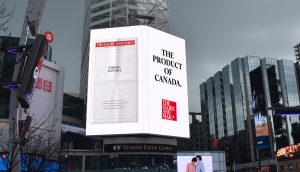BBM Canada’s Staying Tuned media conference took place today in Toronto, with experts from Canada and around the world weighing in on some of the industry’s most pressing issues, including media and advertising effectiveness, assessing integrated campaigns, product placement, and consumer engagement. Media in Canada spoke with two pundits from the U.K. to get their view from across the pond.
David Iddiols gives Virgin, Stella Artois and Barclays Bank the Superglue treatment
David Iddiols, co-founder and senior partner with HPI Research Group in London, explained today how ‘Superglue,’ a research tool developed by HPI, measures the effectiveness of integrated marketing. Superglue, says Iddiols, is neither a predictive nor a planning tool, but rather a way of assessing what role the media components of a campaign play in shaping brand perception. Superglue also gives a good read on the efficiency of media spend over a period of time. HPI has used Superglue for a wide range of brands including Virgin, Barclays Bank, and Stella Artois.
Iddiols explains that the research is carried out on a client-by-client basis using individual interviews and a Web-based approach with participants viewing ads and responding online. The tool looks at how consumers piece together all the different bits of communications to form an overall picture of a brand; somewhat like putting all the various media components of a campaign into a pot and letting consumers decode them to come up with an overall brand picture.
‘What we do is establish the associations that people have of a brand and drill down to how they arrive at those associations. The metric we’ve used is to look at overall brand perceptions and whether the messaging that has taken place through their choice of media has an actual effect on overriding brand perceptions,’ he explains.
With respect to Virgin, he says, consumer perceptions of the brand were all positive. They viewed the brand a little bit innovative, irreverent, and in terms of Virgin’s financial products, it was seen as kind of a ‘Robin Hood’ of brands, a consumer champion.
‘We’ve looked at Virgin, [and] found the paid-for communications mix has been one of the things that has helped the perception of that brand,’ says Iddiols, ‘And that’s quite a tough one because you’re dealing with other kinds of influences on the brand identity. [It] might be someone flying Virgin Air or [their] perception of Richard Branson or whatever. We found that advertising material has actually played a part in molding the perception of that brand.’
Similarly, Iddiols says Stella Artois is a good example of a well-glued together campaign. The advertising has been consistent both over time and across various media, and therefore has the ability to influence people’s perceptions of its brand more than others that may be using a less integrated campaign approach. The result, he says, is a very coherent, crystallized brand message that consumers are able to work with.
‘Stella is one where consumers really drink the advertising – the whole positioning, certainly in the U.K. is ‘reassuringly expensive’. All the glue points in that direction – a nice cinematic feel to [the] TV commercials, and [the] print work seems to have a premium, aspirational appeal to it. The drink in the U.K. is certainly quite aspirational and one of the most consumed lager brands. In image it has this high-end feel that people yearn for.’
On the other hand, Barclays Bank didn’t fare as well. Iddiols says the company had a beautifully glued-together campaign. Unfortunately, the ‘glue’ was a negative one. Consumers considered the brand rather monolithic and profiteering. As a result of the Superglue research, Barclays changed its communications strategy.
MIC puts Mindshare’s Sheila Byfield on the MIC. See next article.

















